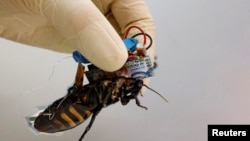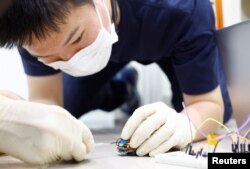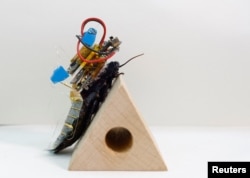Most of the time, people are not happy to see cockroaches. The insect is known around the world as a pest – a creature that causes problems for people.
However, the cockroach is a useful insect for research scientists. And they could one day be used to help find survivors after major earthquakes.
Scientists in Japan have been working on a system that they can attach to the insects that permits remote control.
Kenjiro Fukuda leads a team at the Thin-Film Device Laboratory at Riken, a company that does scientific research. The team created a thin solar cell they can attach to the body of a cockroach. It is thinner than a human hair.
The cell permits the cockroach to move freely but it sends signals to organs that control the insect’s legs.
The scientists believe they can control the cockroaches from a long distance. This means they will be able to send the insects into a disaster area, such as a building destroyed by an earthquake. The small insects can get into places that humans and even rescue robots cannot reach. With the right equipment, they could be used to help find survivors stuck under broken pieces of buildings.
The work advances a project done by scientists in Singapore.
Fukoda said the problem with rescue robots is their batteries run out quickly. The insect, however, moves on its own. The battery only sends a signal that makes the cockroach move, so it lasts much longer.
“The electricity required is nowhere near as much” as what is required for rescue robots, Fukoda said.
The research team is using hissing cockroaches from Madagascar. Those cockroaches are big enough to carry the equipment and strong enough to get back on their feet if they fall over.
Although the research is going well so far, the technology is not fully ready for use in the real world. For example, in a recent demonstration, the scientists sent signals to a cockroach that caused it to move to the left. However, the cockroach moved in circles when they sent a signal telling it to move right.
The next step is to see if there are small cameras and sensors that can be placed on the cockroach’s back. The team created the first test backpack using material purchased from an electronics market in Tokyo for only $35.
Even if the thin solar cell is not able to be used in rescue missions, Fukoda said there could be a number of future uses.
For example, the cells could be used in clothing to measure a person’s health. The cells could also be added to an umbrella. Used in this way, the cells could help generate enough power to charge a mobile phone.
I’m Dan Friedell.
Dan Friedell adapted this story for VOA Learning English based on a report by Reuters.
_______________________________________________________________________
Words in This Story
remote –adj. far away or distant
umbrella –n. an item you hold that protects you from the rain and sun
_______________________________________________________________________
We want to hear from you. Do you think the scientists will make the remote control work for the cockroaches?
We have a new comment system. Here is how it works:
- Write your comment in the box.
- Under the box, you can see four images for social media accounts. They are for Disqus, Facebook, Twitter and Google.
- Click on one image and a box appears. Enter the login for your social media account. Or you may create one on the Disqus system. It is the blue circle with “D” on it. It is free.
Each time you return to comment on the Learning English site, you can use your account and see your comments and replies to them. Our comment policy is here.















Forum